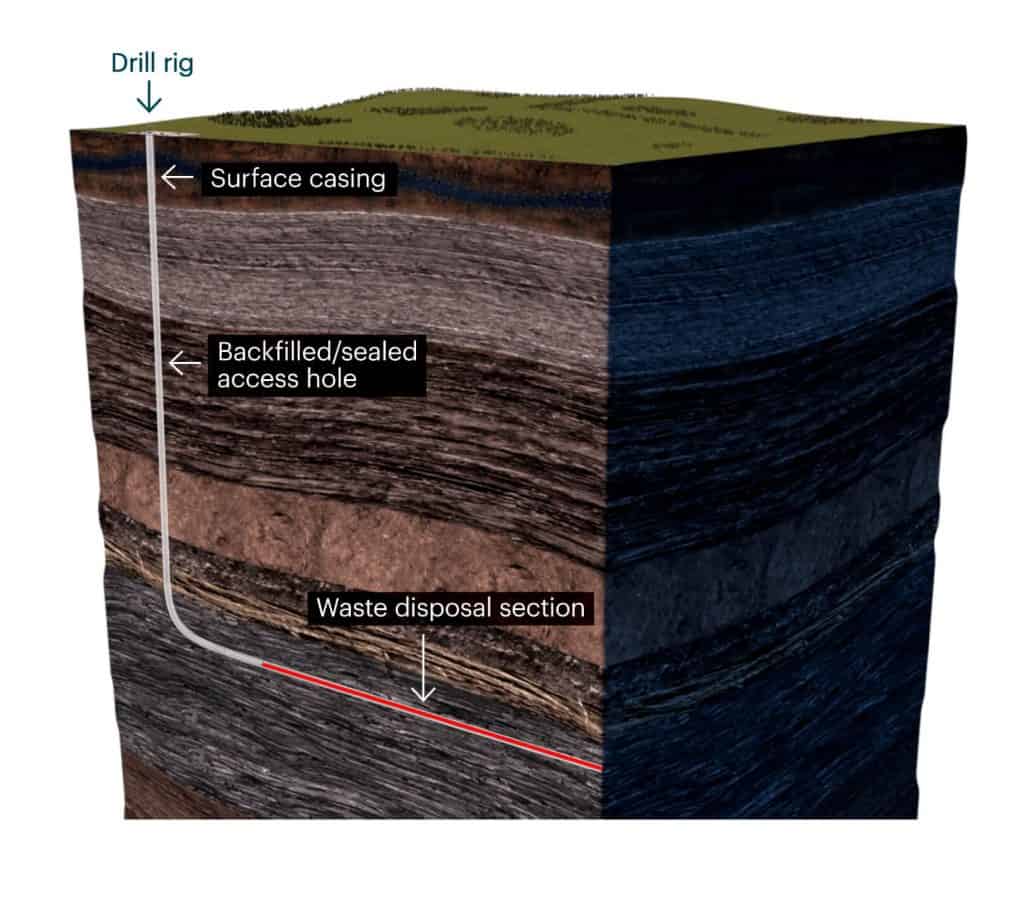Atomic Show #273 – Liz Muller, Deep Isolation

Liz Muller is a co-founder and the CEO of Deep Isolation, a company that makes the modest claim of having invented a solution to nuclear waste.
The politically unsolved waste issue has plagued nuclear energy development since the mid 1970s. That was when it became abundantly clear that the original plan to recycle used fuel wasn’t going to be easily achieved.
During the intervening half century, it’s accurate to declare that there has been essentially no measurable progress made. Steps have been taken to move forward, but just as many steps have been taken in the opposite direction.
Until recently.
Inspired to think differently
The bright idea that forms the basis for Deep Isolation came to Richard Muller when he heard that there was interest in using boreholes as a way to achieve geologic storage. That is the solution path that most responsible scientific organizations have recommended.
In lingo common among my former shipmates, Muller experienced a BFO – blinding flash of the obvious.
But soon Muller realized that the people who had restarted the discussion about boreholes, a rather old idea for nuclear waste disposal, weren’t planning to use horizontal drilling. Instead they were thinking of very deep vertical holes.
He had initially thought they were taking the obvious – to him – step of capitalizing on the refined technology used in almost all state-of-the- art oil and gas wells in the United States.
Though he had not previously considered how boreholes might help solve the nuclear waste issue, he recognized that horizontal laterals mitigated most of the challenges that plagued vertical holes.
Partnering with a specialist in community engagement
Once Richard Muller had been inspired to think of using horizontal drilling to address nuclear waste disposal, he turned to Liz Muller, who was a specialist in environmental issues and related community engagement.
After several months of focused technical evaluation efforts, the pair realized that their concept had sufficient merit and patentable intellectual property to turn it into a company.
Deep Isolation believes that its solution is not only technically sound, but it is uniquely well-suited to deployment. It’s a modular, local or regional solution to an often contentious problem that is gains political complexity when handled on a national level.
From a project management point of view, boreholes can reduce costs, risks, and schedules compared to a centrally sited repository. From a community point of view, they can address issues of equity, proof of safety, and community benefits.
Acceptance building rapidly
Like all newly formed companies with a great idea, Deep Isolation realized there was no direct linkage between having a uniquely valuable idea and achieving success in implementing that idea.
During the past year, however, the company has been successfully attracting a talented team, building an impressive roster of advisors, obtaining $14 million in seed capital and attracting solid partners in the form of Bechtel and NAC International.
Liz Muller joined me on the day after the 50th Anniversary of Earth Day to describe the company that she and Richard have co-founded. She explained the technology, spoke about the continuing efforts to engage with communities and Deep Isolation’s approach to meeting customer needs.
She told me a bit about the company’s finances and provided a direct point of contact to her for people who listened to the Atomic Show. To protect her from spammers, I won’t include that information here, but it’s in the audio.
I hope you enjoy the show. As always, feedback is welcome.
I’d also like to encourage Atomic Insights listeners, especially those who love to get into technical details, to take Ms. Muller up on her request for comments and feedback about their recently released safety calculations.
Here’s a link to a video that illustrates Deep Isolation’s technology.
Podcast: Play in new window | Download (Duration: 38:26 — 44.1MB)
Subscribe: RSS




I saw this elsewhere a while ago, and agree.
The linked video fails to note the signature virtues of the method: troublesome substances which migrate upward head toward the blind end of the borehole and are trapped beneath the caprock, while troublesome substances which migrate downward can get no further than the bottom of the curve of the borehole. And that’s where they stay, by design.
With proper fuel reprocessing and reclamation, we really won’t need storage beyond a few hundred years save for a few long-lived isotopes like Tc-99 and I-129. Isotopes like Cs-137 will have immediate uses such as food sterilization. Barely 6% of LWR SNF is even transmuted. We really need to be making use of this stuff rather than deeming it all “waste”.
BTW, good work on the audio levels between the intro and podcast proper. I wish you had edited out the “ums”.
The key to any scheme for future generations is going to be retrievability.
The best thing that Yucca Mountain had going for it was that the mountain was not allowed to be closed for 100 years. That’s plenty of time to pull the “waste” back out and get energy from it.
Anything that bills itself as more “efficient” at getting the stuff plugged underground I consider with suspicion. Nuclear “waste” is not a problem now and is not a problem if it sits that the YM site, and it’s easier to track what you have if it is all consolidated at one site.
This strikes me as a plan to quickly get the stuff buried deep. And then a few decades later, we’ll be drilling to get the stuff back up. It’s a huge waste of effort and money, but I suppose it can be very profitable for companies that specialize in borehole drilling. That’s my cynical view.
This isn’t the only game in town by far; Holtec is planning an interim storage facility in New Mexico. My understanding is that Deep Isolation has already demonstrated placement and retrieval of dummy fuel packages.
Thus, Holtec.
I’m more sanguine than you are. This strikes me as a way to counter the persistent “what about the waste?” line from the anti-nukes. De-fanging that bit of propaganda is worth whatever it costs to demonstrate borehole disposal (we don’t have to use it, just have it), and since at least one state law prohibits new nuclear construction until there is a disposal site, it pays legal dividends too.
Thanks, Rod. At the end of the interview, you asked Liz if there was anything she wanted to add. I think she should have talked about their proof of concept demonstration on January 16, 2019, in which a small, empty canister was deposited in a borehole and then retrieved. There’s a page for the demo on their site, but they didn’t include the documentary:
https://youtu.be/3GZ4TC8ttbE
I think there are a lot of people who want the “nuclear waste” issue kept alive for either political reasons or to help justify their opposition to nuclear energy.
Several reply comments. Seems to me that Nevada has contributed to Nuclear waste and has been the recipient of significant economic benefits from DOD/DOE nuclear science for decades. They are contributory. In addition, Nevada has significant Air Force and other DOD installations within the state that contribute significant tax revenues in nonnuclear operations. Also, many of the nuclear reactors in Energy production are along U.S. coasts. The same coasts under siege from climate change mass flooding. Centralizing repository away from coasts is most prudent. There has NEVER been any nuclear accident when transporting nuclear waste in the past 50 years in the U.S. I propose only using the safest transportation in the world to transport the materials into storage, and avoid highways, rails, or other vulnerable methods. Good luck!
WIPP was the perfect solution for storing unwanted radioactive waste, but some politicians had this wild idea that maybe someday, some of the material there would be of use in the future and had to be retrievable. Anything stored in WIPP would never be retrievable from the salt rock after a few years. Therefore, a second site was needed for the unused spent nuclear fuel from all nuclear reactors, whether private commercial reactors or military reactors from the Navy.
After decades of trying to find a second storage site for retrievable unused radioactive fuel, it is ironic that the two sites being considered are right back in Southeast New Mexico and West Texas, also known as the Permian Basin. WHY? Because the politicians cannot change the science of geology (or chemistry). It is what it is.
Before I listened to this PODCAST, I thought deep borehole would be a good solution for permanent solution HLW, but after listening to this interview I have completely changed my mind. This solution seems simple on the surface, but turned out to be very complex to implement. I don’t think this is a viable solution for retrievable SNF.
I agree this solution does have value in storing fission products, non-usable fuels as a permanent waste. However, it only takes a policy change to store this material in WIPP.